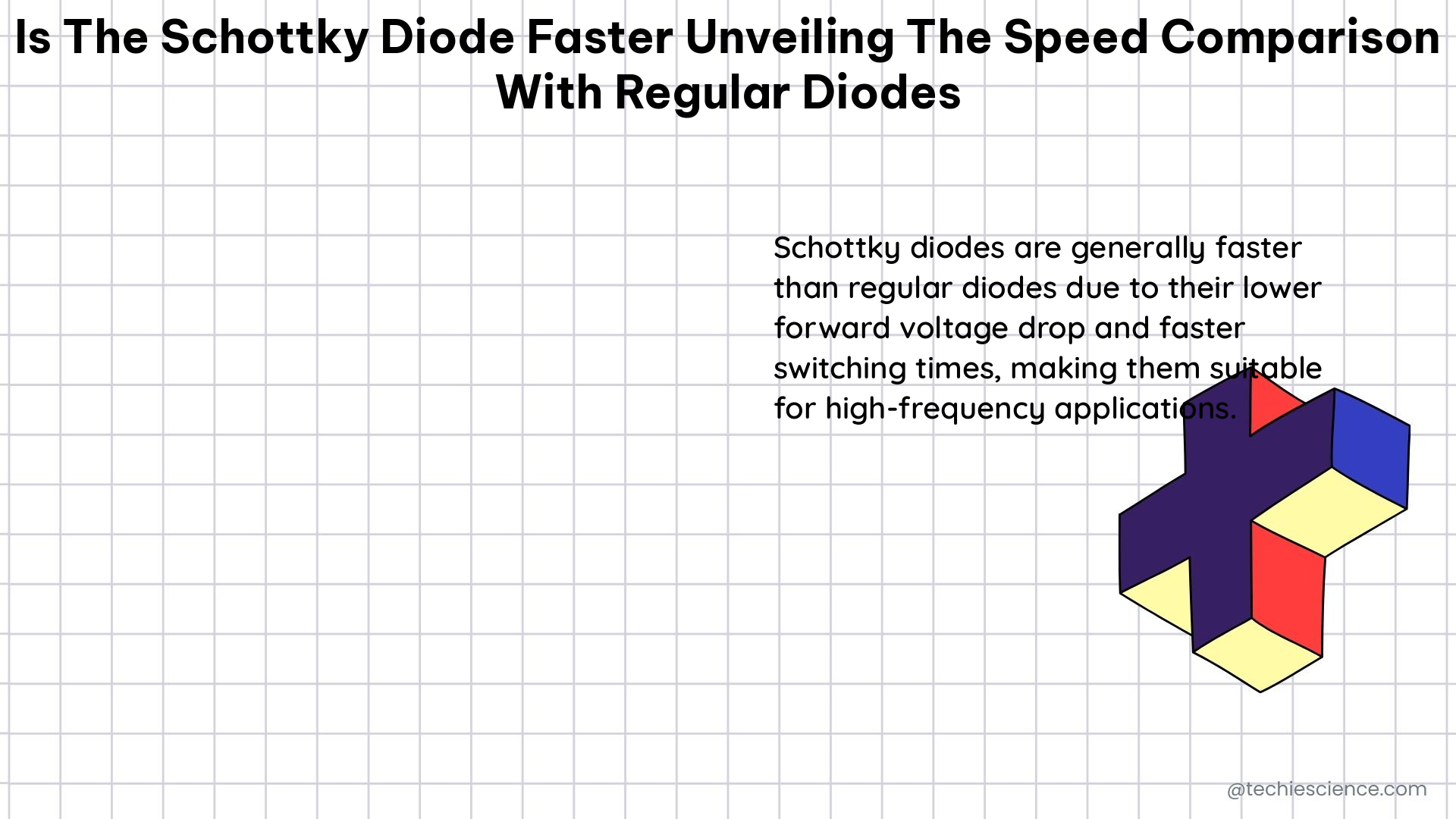Schottky diodes are a type of semiconductor diode that exhibit faster switching speeds and lower forward voltage drops compared to traditional p-n junction diodes. This makes them a popular choice for high-frequency and high-efficiency applications. In this comprehensive guide, we’ll delve into the technical details and quantify the speed advantages of Schottky diodes over regular diodes.
Understanding the Fundamental Differences
The key difference between Schottky diodes and regular diodes lies in their junction structure. Schottky diodes have a metal-semiconductor junction, while regular diodes have a p-n junction. This structural difference is the primary driver of the performance advantages of Schottky diodes.
Schottky Diode Junction
In a Schottky diode, the junction is formed between a metal and a semiconductor material, typically n-type semiconductor. This metal-semiconductor junction creates a potential barrier that allows current to flow in one direction but not the other, similar to a traditional p-n junction diode.
Regular Diode Junction
Regular diodes, on the other hand, have a p-n junction, where a p-type semiconductor material is joined with an n-type semiconductor material. This p-n junction forms the basis for the diode’s rectifying behavior.
Comparing Switching Speed

One of the key advantages of Schottky diodes is their faster switching speed, which is primarily due to the absence of a depletion region in the metal-semiconductor junction.
Reverse Recovery Time
The reverse recovery time is a crucial parameter that determines the switching speed of a diode. It is the time it takes for a diode to transition from the conducting state to the blocking state when the voltage is reversed.
Schottky Diode Reverse Recovery Time
Schottky diodes typically have a reverse recovery time in the nanosecond (ns) range, which is significantly faster than regular diodes. For example, the 1N5819 Schottky diode has a reverse recovery time of just 7 ns.
Regular Diode Reverse Recovery Time
In contrast, regular diodes can have reverse recovery times in the microsecond (μs) range. The 1N4007 regular diode, for instance, has a reverse recovery time of 30 μs.
This difference in reverse recovery time translates to a speed advantage of five orders of magnitude for Schottky diodes compared to regular diodes.
Analyzing Forward Voltage Drop
Another important parameter to consider is the forward voltage drop, which is the voltage drop across the diode when it is conducting current.
Schottky Diode Forward Voltage Drop
Schottky diodes have a lower forward voltage drop, typically in the range of 0.2 to 0.3 volts. This is significantly lower than the 0.6 to 0.7 volts found in regular diodes.
Efficiency and Power Consumption
The lower forward voltage drop in Schottky diodes results in lower power consumption and higher efficiency, making them ideal for high-frequency applications where efficiency is critical.
Theoretical Explanation
The faster switching speed of Schottky diodes can be attributed to the absence of a depletion region in the metal-semiconductor junction. In contrast, regular diodes have a depletion region in the p-n junction, which acts as a barrier to current flow and results in a slower switching speed.
Additionally, the narrower electron depletion region in Schottky diodes allows for a faster charge and discharge time, contributing to the faster switching speed.
Applications and Use Cases
Due to their superior switching speed and efficiency, Schottky diodes are widely used in various electronic circuits and applications, including:
- High-frequency power supplies
- Switching power supplies
- Rectifier circuits
- Voltage clamping circuits
- Mixer and detector circuits in RF and microwave systems
Conclusion
In summary, Schottky diodes are indeed faster than regular diodes, with a significantly faster switching speed and lower reverse recovery time. This is primarily due to the metal-semiconductor junction in Schottky diodes, which results in a narrower electron depletion region compared to the p-n junction in regular diodes. The lower forward voltage drop in Schottky diodes also contributes to their higher efficiency and lower power consumption, making them ideal for high-frequency applications.
References
- Difference Between Schottky Diode and Normal Diode – YouTube
- Difference Between a Normal Diode and a Schottky Diode
- Schottky vs Standard Diode – TechForum DigiKey
- Normal Diode vs Schottky Diode – Mike Holt’s Forum
- Schottky vs Conventional Diodes: Circuit Analysis Guide – LinkedIn

The lambdageeks.com Core SME Team is a group of experienced subject matter experts from diverse scientific and technical fields including Physics, Chemistry, Technology,Electronics & Electrical Engineering, Automotive, Mechanical Engineering. Our team collaborates to create high-quality, well-researched articles on a wide range of science and technology topics for the lambdageeks.com website.
All Our Senior SME are having more than 7 Years of experience in the respective fields . They are either Working Industry Professionals or assocaited With different Universities. Refer Our Authors Page to get to know About our Core SMEs.